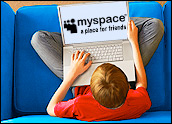
MySpace claimed almost 5 million registered users in 2005, and that number has grown to exceed 70 million today. Though currently the most popular, MySpace is only one of a number ofsocial networking sites online, and their attractiveness to teens and pre-teens has spawned worry over a growing Internet menace.
One in five kids ages 10 to 17 have received a sexual solicitation through the Internet, according to “Online Victimization: A Report on the Nation’s Youth,” a study conducted in 2000 by the National Center for Missing and Exploited Children (NMCEC).
In addition, almost half of the teens who use online chat systems have replied to messages from someone they didn’t know, suggests a teen Internet survey conducted in March 2006. The research was funded by Cox Communications in partnership with NCMEC.
More than half of the teen survey participants with Internet access said they had placed their profiles on a social networking site, and half of that group reported posting their pictures.
Congressman Michael Fitzpatrick, R-Pa., recently introduced HR 5319, the “Deleting Online Predators Act of 2006” (DOPA), which would ban access to social networking sites in schools and libraries.
The bill defines a social networking site as “a commercially operated Internet Web site that — (i) allows users to create Web pages or profiles that provide information about themselves and are available to other users; and (ii) offers a mechanism for communication with other users, such as a forum, chat room, e-mail, or instant messenger.”
Goes Too Far?
DOPA is criticized as redundant in some quarters.
“Public schools and school libraries that receive federal funds are already required to filter Internet content that is ‘obscene, child pornography or harmful to minors’ under CIPA, the Children’s Internet Protection Act,” said American Library Association Washington Communications Director Bernadette Murphy.
Some critics say the language is too broad and would include collaborative networking sites such asWikipedia.
“It’s a safe assumption that this legislation is targeting sites such as MySpace and Friendster, which are primarily used by kids to hang out. But social networking sites also include professional resources like LinkedIn,” Michael Gersh, vice president of sales and marketing atMultiply, told TechNewsWorld.
“The Internet is changing how we live and interact with one another — it’s enabled great advancements in distance learning and collaborative learning communities. HR 5319 would squash kids’ first attempts at becoming acquainted with applications that will soon be essential workplace tools,” Murphy said.
Others argue that while regulation is necessary, it should not be legislated.
“Schools are for learning, not for online shopping and networking,” commented Christina Slenk, director of education and training withWeb Wise Kids, a nonprofit organization that provides strategies for safe Internet use. That said, Slenk told TechNewsWorld the decision on which sites to exclude from student access belongs with schools or school districts rather than with Congress.
Does Too Little?
While some fear the extent of DOPA’s reach, others view the bill as an inadequate response to the challenge.
“This legislation only addresses online activities at schools and libraries. There are many problems occurring at school related to off-campus online activities of teens. So this legislation comes nowhere close to addressing the concerns,” Nancy Willard, executive director at the Center for Safe and Responsible Internet Use, told TechNewsWorld. Willard authored the forthcoming book, Raising CyberSavvy Kids: Empowering Children and Teens to Make Safe and Responsible Choices Online.
“Legislation like DOPA gives parents a false sense of security — there are no quick and easy answers to the problem of predators on the Web or out in the world,” added Murphy.
“We need a real commitment from Congress on the effort to educate kids and parents about appropriate use of Web technologies,” she urged. “Legislation like DOPA is like putting a band-aid on a gunshot wound.”
There is already technology in place that would make the legislation ineffective, even if it were passed, say some opponents. For example, students at schools that already have filters in place often figure out how to get around them to access forbidden Web sites.
Kids can access the Internet using devices other than computers, too. Now that cell phones and handhelds are Internet-capable, students can easily use them to go anywhere online even if school or library computers have restricted access, pointed out Clemson University Professor of Psychology Robin M. Kowalski, Ph.D., who conducted a national study on cyber-bullying.
“The crazy thing is that the U.S. government itself actually provided funding for the creation of any easy-to-implement system to circumvent filters,” noted Willard. She mentioned Circumventor from Peacefire, which was developed with support from Voice of America.
Then there’s the big question: “Who is really going to be enforcing the law?” Kowalski asked.
Seeking Better Solutions
Media attention to MySpace has increased awareness of social networking and the problems that accompany it, but the only solution so far that seems to have gained broad support is education.
“Banning the sites at school reduces school liability; however, keeping children safe — period — wherever they are, involves not the controlling of computers, or more staff at MySpace monitoring the content, but the education of children and families about safety.” Slenk argued.
Educating parents and providing information using diverse venues will help in the fight against online predators, Willard maintained.
“Ensure that all sites eliminate any chat rooms or discussion groups that have names that suggest engagement of youth with adults for sexual purposes. Also ensure that every such site has an effective response mechanism to address any reports or suspicions of sexual solicitation of youth,” she suggested.
Organizations like Web Wise Kids provide free programs to schools and police departments. The organization recently released Mirror Image, a computer game that teaches online safety to teens.
NMCEC’sNetSmartz Workshop provides interactive and educational resources on online safety. Some school districts, city officials and state representatives have held town halls and learning sessions on cybersafety to increase awareness.
Despite existing laws, it is common knowledge that underage kids find ways to get liquor and cigarettes quite easily. Access to social networking sites unquestionably would be far more difficult to regulate than the sale of alcohol and tobacco to minors.
Parents are urged to talk with their children about sex, drugs, smoking and other potentially risky behaviors. Now, frank discussions about online safety should be added to this repertoire, educators and child-protection advocates agree.
The “bottom line is that the online predator issue comes down to a parent’s responsibility. Those conversations now need to have an online perspective,” Gersh advised.



















































